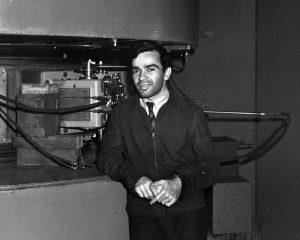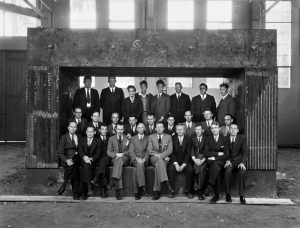
Martin Kamen is not a household name today, but his synthesis of Carbon 14 in February 1940 was the first of many achievements in his long career as a chemist. In 1944, Kamen, a chemist in the new field of radiochemistry, worked for the Manhattan Project at Berkeley Radiation Laberatory and Oak Ridge, Tennessee. The FBI investigated Kamen and his contacts at the Russian consulate in San Francisco and he lost his security clearance and his job at the Berkeley Radiation Laboratory. Fortunately, that was not the end of the story. An offer came from Washington University in 1945.
Early years (1930-36): Musical prodigy becomes chemist
In his 1986 memoir, Kamen described himself a child uninterested in mechanical toys and a child prodigy in music who disliked center stage and hence avoided the limelight in his scientific career. He first chose English as his major when he enrolled at the University of Chicago in 1930 in the heart of the Depression. However, in 1931, money troubles in his father’s photography studio led his father to advise a change to chemistry, a better path to a paying job. Kamen dove into the chemistry major and its prerequisites in math and physics and discovered his passion for experimental science. Kamen’s early research was under Dr. W.D. Harkins and Dr. D.M. Gans in Harkins’ research program that combined the disparate fields of nuclear physics and surface chemistry. Kamen earned his bachelor’s degree cum laude (1933) and a doctorate in physical chemistry (1936) at a time when the job market was grim. But Gans provided thoughtful and imaginative guidance to Kamen that worked out beautifully, as Kamen recounted:
Gans suggested I spend some time at the famed Radiation Laboratory in Berkeley, California, where the charismatic Ernest O. Lawrence had developed the cyclotron as the most powerful tool of nuclear physics. Harkins intended to build a cyclotron in Chicago, and I could expect to be taken on as a research assistant provided I could claim some expertise as a cyclotroneer. The Radiation Laboratory was Mecca for all aspiring young nuclear physicists, and I was intrigued at the prospect of going there. Working as a photographer, and saving proceeds of various engagements as a jazz fiddler over the Christmas season, I left for Berkeley just as the new year of 1937 was dawning.
The Cyclotroneers in peace and war: 1937-1944

Serendipity continued its sway as events moved forward. I joined with E. M. (“Ed”) McMillan, a young laboratory staff member who was already a leader in the field of nuclear physics, to straighten out some anomalous results Lawrence had reported on platinum transmutation by deuterons. We welcomed a young graduate student from the department of chemistry, Samuel Ruben, to help with the difficult platinum metal radiochemistry needed to sort out the activities observed when platinum was bombarded by highly energetic deuterons (up to 8 MeV).
Ruben and Kamen began their own creative effort to study the process of photosynthesis using radioactive isotopes. Carbon 14 was a tool they synthesized to trace what was going on with photosynthesis.
In 1941, Lawrence assigned staff to war-related priorities and that meant chemical warfare research for Ruben and the atomic bomb for Kamen. Ruben died in a chemical accident in 1943. Kamen met Russian consular staff through his friend, music legend Isaac Stern. In 1944, Kamen helped one of the Russians find radiation treatment for a friend with leukemia not knowing he was under surveillance by the FBI. A grateful Russian invited Kamen for dinner in a fancy restaurant. The FBI made a file for Kamen with notes and pictures. Kamen claimed he told the Russians nothing about the bomb, but he lost his security clearance and his job at the Berkeley Radiation Laboratory.
Early in 1945, the efforts of the Radiation Laboratory administration to have me placed somewhere outside the Bay Area were successful. I was offered an appointment in the Washington University Medical School in St. Louis. The opportunity to begin a new career was welcomed eagerly, although I left Berkeley most reluctantly. (Kamen, “A cupful of luck, a pinch of sagacity,” 1986).
I received a surprise visit from Robert Thornton, a mainstay of E.O.L’s (Lawrence) group… He came with an attractive offer of academic employment. He said the Medical School at Washington University in St. Louis was anxious to acquire my services to take over supervision of a cyclotron and its use in medical and biological research. The cyclotron had been built by Bob [Thornton] and Alex Langsdorf in the period just prior to 1942. Bob had returned to Berkeley at E.O. L.’s request to work on the [Manhattan] project and appeared unlikely to return to St. Louis…I learned later that Arthur Compton, slated to take over as chancellor at Washington University, had phoned E.O.L. to ask his advice on my proposed appointment and had been told by Lawrence that there not only was no question that I had necessary qualifications, but that he was confident that any investigation that might develop would disclose no grounds to doubt my loyalty as a U.S. citizen. Kamen, “Dark Politics, Radiant Science: memoir of the nuclear age” (1985).
Sources
(1946-1957). Bulletin of Washington University School of Medicine, pp. 1946, page 10; 1947, page 14; 1948, page 13, page 137-138. Retrieved from https://digitalcommons.wustl.edu/cgi/viewcontent.cgi?referer=&httpsredir=1&article=1057&context=med_bulletins
Cooksey, D. p. (1938, September). Staff of the Radiation Laboratory and Physics Department closely associated with the work on the 60-inch cyclotron., taken September, 1938. Back row: D.H. Slone, R. Corog, M.D. Kamen, W.B. Mann, J.R. Oppenheimer, E.S. Viez, D.C. Kalbfell, W.W. Sillsbury. Retrieved from U.S. National Archives: Public Domain Archive not developed or endorsed by NARA: https://nara.getarchive.net/media/staff-of-the-radiation-laboratory-and-those-of-the-physics-department-closely-3231de
Cooksey, D. p. (1939, September 10). Martin Kamen at the 60-inch cyclotron, September 10, 1939. . Retrieved from U.S. National Archives, Public Domain Archive not developed or endorsed by NARA: https://nara.getarchive.net/media/martin-kamen-at-the-60-inch-cyclotron-september-10-1939-cooksey-50-photographer-857ced
Kamen, M. D. (1985). Dark Politics, Radiant Science: memoir of the nuclear age. Berkeley: University of California Press. Retrieved April 26, 2019, from http://catalog.wustl.edu/search/o9830883 ; https://books.google.com/books?id=jcV4r2Idqf0C&lpg=PP1&dq=Martin%20Kamen&pg=PP1#v=onepage&q=Martin%20Kamen&f=false
Kamen, M. D. (1986). A cupful of luck, a pinch of sagacity. Ann. Rev. Biochem, 55, 1-44. Retrieved April 23, 2019, from https://www.annualreviews.org/doi/pdf/10.1146/annurev.bi.55.070186.000245
The Enrico Fermi Award: 1990’s, Martin D. Kamen, 1995. (2019). Retrieved April 23, 2019, from U.S. Department of Energy. Office of Science: https://science.energy.gov/fermi/award-laureates/1990s/kamen/
